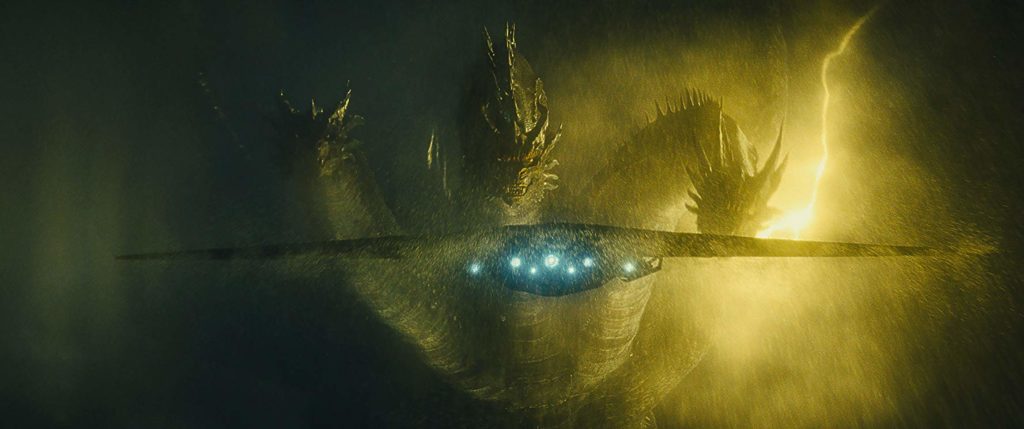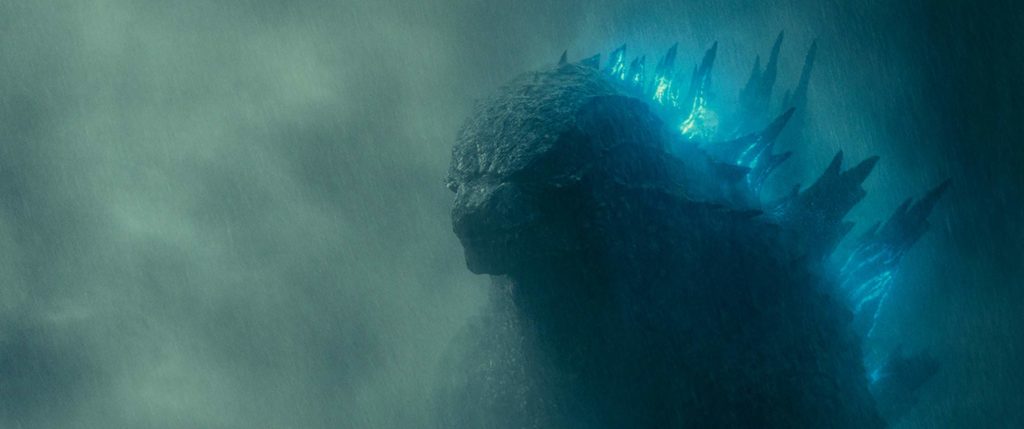Five years after Godzilla becomes known to the world, an eco-dystopian plot is set into action that involves releasing more of these “titans” in order to reverse humanity’s mistakes. Shock almighty(!), it doesn’t work. Instead, titans wreck havoc, led by the three-headed monster Gidorah. Only one other titan can stand up to the apocalypse’s resident bully, and that’s Big G himself. Although Gidorah is not the only one he has to watch out for.

It speaks volumes that each of the four primary monsters are named in the end credits – played not by their motion capture artists, but by ‘themselves.’ Dougherty is letting his kaiju fanboy euphoria overtake him with Godzilla: King of the Monsters, and it works a treat. There are subtle nods and callbacks to the detailed history of the beasts, and a character arc that so deliberately mirrors the bleak finale of the 1954 original (the American re-release of which gives KOTM its name). Such care is taken for each major monster to have its own distinct personality, sounds and look. This is especially true with Gidorah; the fallen angel who is an easy villain to detest, the embodiment of an insidious, repulsive evil. All of these are evolutions of Toho Studios’ original creations, and a stunning demonstration of what modern motion capture can do. Taking in the magnificence, terror and spectacle of these monsters reminds you of why we have movies like this.
Most importantly however, the battles are as vicious and intense as you like. Weirdly for a film with a 500-foot three-headed dragon, some of the final moments feel over the top. Mostly though, the kaijus are finally seen as the best version of themselves. The most heart-pounding set piece is a chase involving the giant pteranodon Rodan near the Mexican coast, but the ultimate showdown is between Godzilla and Gidorah. With these two mighty foes at the centre, KOTM has plenty of moments where it rivals Avengers: Endgame for biggest visual spectacle of the year. Dougherty holds nothing back, raining fire without mercy, and for this he deserves massive credit.
Unfortunately, KOTM can’t really move the MonsterVerse forward like it wants to, since it falls into some all too common pitfalls. As with Godzilla (2014), the humans serve little purpose other than occupying screen time that should be taken up by the monsters. They at least seem less robotic than Aaron Taylor-Johnson’s moody military maverick, but the family dynamic of the Russells is uninspiring. Very much going through the motions as far as the troubled family thread goes, they still emerge as the highlight amongst a spirited cast with little to do. Sally Hawkins especially, after her incredible performance in The Shape of Water (2017), feels wasted here.

The cast aren’t helped by an occasionally appalling script, which takes so long to kick into action. Besides a strange plot based around a device that can summon titans (left out of the trailers for a reason, you suppose) and some nonsensical motivations, the dialogue is shoddy. It does nothing beyond moving the plot along, and suffers from some horribly corny moments. One line in particular is criminally awful – you’ll know it when you hear it. Admittedly however, you don’t watch KOTM for engrossing character work. You watch it to see kaijus kick the shit out of each other, and at least it gets that right.
Don’t let naysayers put you off – Godzilla: King of the Monsters is a lot of fun and a bombastic salute to the franchise’s history. Although, you might want to consider losing a brain cell or six if you want to come away heralding it as a masterpiece. Director Michael Dougherty turns Godzilla up to eleven, but ultimately this beast is all killer and no filler.
Godzilla: King of the Monsters is out now, distributed by Warner Bros.
